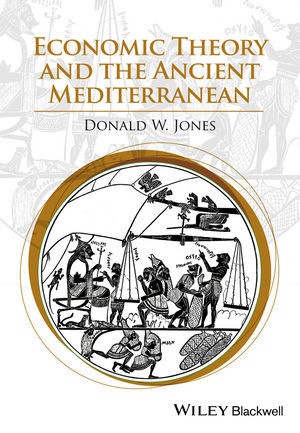Read more
Economic Theory and the Ancient Mediterranean presents a comprehensive introduction to the application of contemporary economic theory to the ancient societies of the Mediterranean Sea from the period of 5000 BCE to 400 CE.
* Offers an accessible presentation of modern economic theory and its relationships to ancient societies
* Presents innovative expositions and applications of economic theory to issues in antiquity not often found in the literature
* Features insightful discussions of the relevance of contemporary economic models to various situations in antiquity
* Written for a broad range of scholars of ancient Mediterranean regions, including archaeologists, ancient historians, and philologists
List of contents
Preface xiii
Acknowledgments xvii
Introduction 1
Rationale 1
Organization 2
Method 3
Reader Outcomes 3
Themes 4
Relevance and Applicability 5
References 6
Notes 6
1 Production 8
1.1 The Production Function 9
1.2 The "Law" of Variable Proportions 11
1.3 Substitution 13
1.4 Measuring Substitution 15
1.5 Specific "Functional Forms" for Production Functions 16
1.6 Attributing Products to Inputs: Distributing Income from Production 17
1.7 Efficiency and the Choice of How to Produce 18
1.8 Predictions of Production Theory 1: Input Price Changes 20
1.9 Predictions of Production Theory 2: Technological Changes 21
1.10 Stocks and Flows 22
1.11 The Distribution of Income 23
1.12 Production Functions in Achaemenid Babylonia 25
References 26
Suggested Readings 27
Notes 27
2 Cost and Supply 29
2.1 The Cost Function 31
2.2 Short Run and Long Run 32
2.3 The Relationship between Cost and Production 33
2.4 Producers' Objectives 34
2.5 Supply Curves 35
2.6 Demands for Factors of Production 40
2.7 Factor Costs in General:Wages and Rents 41
2.8 Allocation of Factors across Activities 43
2.9 Organizing Production:The Firm 43
2.10 A More General Treatment of Cost Functions 46
2.11 The Economics of Mycenaean Vases, I: Supply and Cost 47
2.12 Accounting for Apparent Cost Changes in Minoan Pottery 49
2.13 Production in an Entire Economy: The Production Possibilities Frontier 50
References 52
Suggested Readings 53
Notes 53
3 Consumption 55
3.1 Rationality of the Consumer 57
3.2 The Budget 57
3.3 Utility and Indifference Curves 58
3.4 Demand 60
3.5 Demand Elasticities 63
3.6 Aggregate Demand 65
3.7 Evaluating Changes inWellbeing 66
3.8 Price and Consumption Indexes 70
3.9 Intertemporal Choice 73
3.10 Durable Goods and Discrete Choice 75
3.11 Variety and Differentiated Goods 79
3.12 Value of Time and Household Production 82
3.13 Risk, Risk Aversion, and Expected Utility 86
3.14 Irrational Behavior 88
3.15 Fixed Prices 90
3.16 Applying Demand Concepts: Relationships between Housing Consumption, Housing Prices, and Incomes in Pompeii 93
3.17 The Economics of Mycenaean Vases, II: Demand 96
References 99
Suggested Readings 99
Notes 100
4 Industry Structure and the Types of Competition 103
4.1 Perfect Competition 104
4.2 Competitive Equilibrium 106
4.3 Monopoly 108
4.4 Oligopoly 110
4.5 Monopolistic Competition 111
4.6 Contestable Markets 112
4.7 Buyer's Power: Monopsony 113
4.8 The Economics of Mycenaean Vases, III: Industry Structure 114
4.9 Ancient Monopoly and Oligopoly: Religion and Foreign Trade 115
References 117
Suggested Readings 118
Notes 118
5 General Equilibrium 120
5.1 General Equilibrium as a Fact and as a Model 120
5.2 TheWalrasian Model 124
5.3 Exchange 127
5.4 The Two-Sector Model 128
5.5 Existence and Uniqueness of Equilibrium 133
5.6 Computable General Equilibrium Models 134
References 136
Suggested Readings 137
Notes 137
About the author
Donald W. Jones is Adjunct Professor of Classics, University of Tennessee, and is also an economic consultant involved with demand forecasting and energy economics. He is the author of
External Relations of Early Iron Age Crete, 1100-600 B.C. (2000) and co-editor of
Measuring the Full Costs and Benefits of Transpiration (1997).
Summary
Economic Theory and the Ancient Mediterranean presents a comprehensive introduction to the application of contemporary economic theory to the ancient societies of the Mediterranean Sea from the period of 5000 BCE to 400 CE.
Report
"It is a majestic manual on economics...covering basically the full spectrum of standard economic theory. ...[T]he book is a powerful, even if advanced tool, to develop an understanding of economic theories." (Nordicum-Mediterraneum, 1 January 2015)

